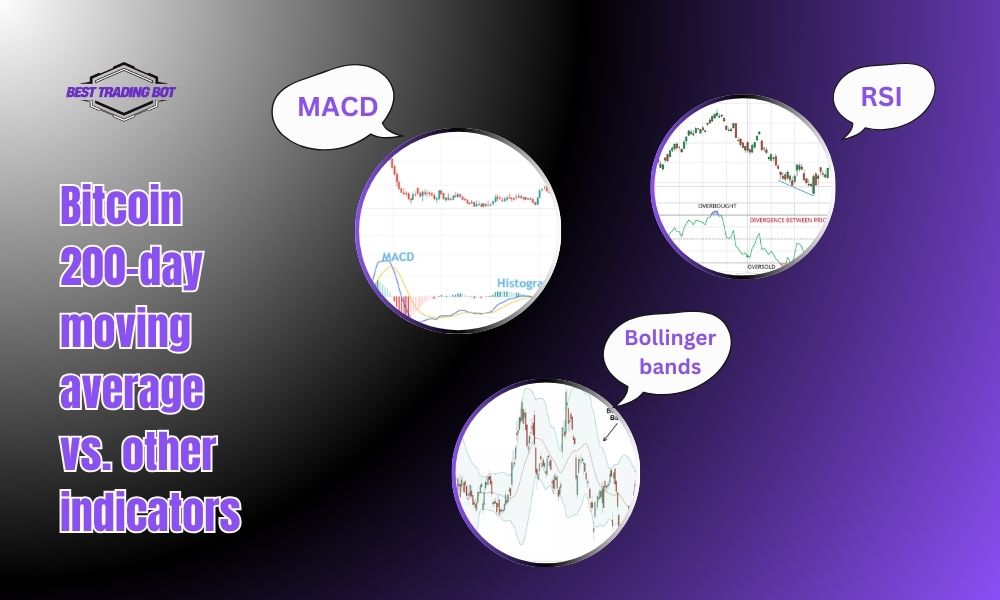Bitcoin 200-day moving average is one of the most crucial technical indicators for cryptocurrency investors. this indicator helps assess bitcoin’s long-term trend, identifying key support and resistance levels. By understanding bitcoin 200-day moving average, investors can make more informed trading decisions and capitalize on market opportunities.

Contents
- 1 What is bitcoin 200-day moving average?
- 2 Significance of bitcoin 200-day moving average
- 3 Real-world examples of bitcoin 200-day moving average
- 4 How to use bitcoin 200-day moving average in trading
- 5 Bitcoin 200-day moving average vs. other indicators
- 6 Bitcoin 200-day moving average and market sentiment
- 7 Current bitcoin situation relative to bitcoin 200-day moving average
What is bitcoin 200-day moving average?
Bitcoin 200-day moving average is the 200-day moving average line, calculated by taking the average closing price of bitcoin over the past 200 days. This indicator reflects bitcoin’s overall long-term trend, helping determine whether the market is in a bullish or bearish phase.
When bitcoin’s price is above bitcoin 200-day moving average, it often indicates a strong uptrend. Conversely, if the price falls below this level, it may signal a bearish market, where bitcoin prices tend to decline over an extended period.
Bitcoin 200-day moving average is widely used by traders and institutional investors to assess market health. When the price crosses above the 200-day moving average, it can be a strong buy signal, whereas crossing below may indicate a selling opportunity.
Significance of bitcoin 200-day moving average
Bitcoin 200-day moving average is more than just a simple indicator; it plays a vital role in defining the market’s primary trend. It provides investors with a broader perspective, helping them avoid being influenced by short-term price fluctuations.
In previous bull cycles, bitcoin has remained above the 200-day moving average during sustained uptrends. This highlights the strength of long-term trends and the increasing interest from investors. On the other hand, when bitcoin’s price stays below bitcoin 200-day moving average, the market often experiences stronger downward pressure, reflecting investor caution.
Moreover, bitcoin 200-day moving average is used to identify support and resistance zones. If bitcoin’s price rebounds from this moving average, it may act as a strong support level. Conversely, if the price fails to break above the moving average, it could serve as a significant resistance point.
Real-world examples of bitcoin 200-day moving average
Historically, bitcoin 200-day moving average has played a crucial role in predicting major market movements:
- In 2020, bitcoin broke above its 200-day moving average after the covid-19 market crash, leading to an extended bull run that pushed its price beyond $60,000.
- In 2022, bitcoin fell below its 200-day moving average and struggled to recover, marking the start of a prolonged bearish phase.
- In 2023, bitcoin reclaimed the 200-day moving average after months of consolidation, signaling renewed investor confidence.
These examples illustrate how the 200-day moving average can provide valuable insights into bitcoin’s long-term price action.
How to use bitcoin 200-day moving average in trading
Many traders use bitcoin 200-day moving average as an indicator to make informed buy and sell decisions. There are several common strategies based on this indicator that investors can apply to optimize their profits.
One popular strategy is trend-following trading. When bitcoin’s price remains above bitcoin 200-day moving average, investors may consider opening buy positions to take advantage of the uptrend. On the other hand, when the price drops below the moving average, this can be a sell signal to minimize potential losses.
Additionally, some traders combine bitcoin 200-day moving average with other indicators like rsi or macd to increase trading accuracy. For example, if bitcoin’s price crosses above the 200-day moving average while macd provides a buy signal, it could be a strong opportunity for investment.
Bitcoin 200-day moving average vs. other indicators
While the 200-day moving average is a powerful tool, it is often combined with other indicators for better results:
- Relative strength index (rsi): used to identify overbought or oversold conditions, helping confirm trend reversals.
- Macd (moving average convergence divergence): provides momentum-based signals to validate trends indicated by the 200-day moving average.
- Bollinger bands: helps measure price volatility and potential breakout opportunities.
Using multiple indicators in combination can enhance trading accuracy and reduce false signals.

Bitcoin 200-day moving average and market sentiment
The 200-day moving average also serves as a psychological benchmark for traders and investors. When bitcoin trades above this level, it boosts confidence and attracts more buyers. However, when the price remains below the 200-day moving average for an extended period, fear and uncertainty can dominate the market.
Many institutional investors use this moving average to assess market sentiment and decide on their long-term investment strategies. Understanding how the 200-day moving average aligns with investor psychology can provide additional insights into market trends.
Current bitcoin situation relative to bitcoin 200-day moving average
Monitoring bitcoin 200-day moving average helps investors assess the current market condition. If bitcoin’s price is above this moving average, the market is likely in a bullish phase. However, if the price stays below this level for an extended period, the market could be in a bearish trend.
Investors often observe how bitcoin’s price reacts to bitcoin 200-day moving average to predict future trends. If the price bounces from this moving average with high trading volume, it may indicate that the uptrend is still strong. On the other hand, if the price breaks below the moving average and declines further, it may signal upcoming negative price movements..
Bitcoin 200-day moving average is a key technical indicator that helps investors assess bitcoin’s long-term trend. When used correctly, it can aid in identifying optimal buy and sell points, reducing trading risks. Regularly tracking bitcoin 200-day moving average provides investors with a clearer view of the market. Stay updated for more valuable insights and explore Best Trading Bots to maximize your profits.
